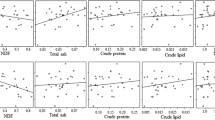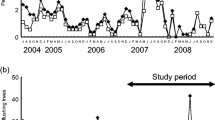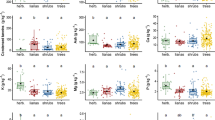Abstract
The feeding selection of leaves by chimpanzees was investigated from the perspective of phytochemistry and leaf availability. Field data were collected for 6 months from 1995 to 1996 and 8 months from 1997 to 1998 in Bossou, Guinea. Time budgets of leaf consumption by chimpanzees were analysed and the abundance of young leaves of each tree species for each month was estimated. Analyses of dried materials, stratified by leaf maturity and edibility, for the relative amounts of crude protein, crude fat, neutral detergent fiber, ash, and condensed tannin were determined. It was found that 1) leaves consumed by chimpanzees had higher levels of ash and lower levels of condensed tannin than leaves that were not eaten; 2) feeding selectivity was correlated with crude protein content; and 3) the availability of young leaves was not correlated with the percentage of feeding time, neither by seasonal changes nor by tree species. Chimpanzees preferred leaves containing higher protein content, but did not consume leaves containing high condensed tannin regardless of protein content. It seems reasonable to consider that a different rule exists for “whether chimpanzees eat it or not” and “whether they prefer it or not” in phytochemical determinants of leaves. Some Moraceae species, which had low levels of condensed tannins, even in mature leaves, were an important food source for the Bossou chimpanzees.
Similar content being viewed by others
References
Adam, J. G. 1971–83. Flore Descriptive des Monts Nimba. Editions du Muséum, Paris. [In French]
Altman, J. 1974. Observational study of behavior: Sampling methods Behavior 49:227–267.
Behmer, S. T., Simpson, S. J., and Raubenhemer, D. 2002. Herbivore foraging in chemically heterogeneous environments: Nutrients and secondary metabolites. Ecology 83:2489–2501.
Bell, R. H. V. 1971. A grazing ecosystem in the Serengeti. Sci. Am. 225:86–93.
Bryant, J. P., Reichardt, P. B., Clausen, T. P., Provenza, F. D., and Kuropat, P. J. 1992. Woody plant–mammal interactions, pp. 344–371, in G. A. Rosenthal and M. R. Berenbaum (Eds.). Herbivores: Their Interactions with Secondary Plant Metabolites, 2nd Edition. Academic Press, San Diego, California.
Calvert, J. J. 1985. Food selection by western gorillas (G. g. gorilla) in relation to food chemistry. Oecologia 65:236–246.
Caughley, G. and Sinclair, A. R. E. 1994. Wildlife Ecology and Management. Blackwell Science, Cambridge.
Coley, P. D. 1983. Herbivory and defensive characteristics of tree species in a lowland tropical forest. Ecol. Monogr. 53:209–233.
Cooper, S. M. and Owen-Smith, N. 1985. Condensed tannins deter feeding by browsing ruminants in a South African savanna. Oecologia 67:142–146.
Dasilva, G. L. 1994. Diet of Colobus polykomos on Tiwai Island: Selection of food in relation to its seasonal abundance and nutritional quality. Int. J. Primatol. 17:63–84.
Dunbar, R. I. 1988. Primate Social Systems. Cornell University Press, New York.
Fleagle, J. G. 1999. Primate Adaptation and Evolution, 2nd Edition. Academic Press, San Diego, California.
Freeland, W. J. and Janzen, D. H. 1974. Strategies in herbivory by mammals: The role of plant secondary compounds. Am. Nat. 108:269–289.
Glander, K. E. 1981. Feeding patterns in mantled howling monkeys, pp. 231–257, in A. C. Kamil and T. D. Sargent (Eds.). Foraging Behavior: Ecological, and Psychological Approaches. Garland Press, New York.
Hagerman, A. E. 1988. Extraction of tannin from fresh and preserved leaves. J. Chem. Ecol. 15:655–680.
Hagerman, A. E. and Butler, L. G. 1991. Tannins and lignins, pp. 355–388, in G. A. Rosenthal and M. R. Berenbaum (Eds.). Herbivores: Their Interactions with Secondary Plant Metabolites, Vol. I, The Chemical Participants, 2nd Edition. Academic Press, San Diego, California.
Harborne, J. B. 1993. Introduction to Ecological Biochemistry, 4th Edition. Academic Press, London.
Hladik, C. M. 1977a. Chimpanzees of Gabon and chimpanzees of Gombe: Some comparative data on the diet, pp. 483–501, in T. H. Clutton-Brock (ed.). Primate Ecology. Academic Press, London.
Hladik, C. M. 1977b. Field methods for processing food samples, pp. 595–601, in T. H. Clutton-Brock (ed.). Primate Ecology. Academic Press, London.
Hladik, C. M. 1978. Adaptive strategies of primates in relation to leaf-eating, pp. 373–395, in C. G. Montgomery (ed.). The Ecology of Arboreal Folivores. Smithsonian Institution Press, Washington, DC.
Howe, H. F. and Westley, L. C. 1988. Ecological Relationships of Plants and Animals. Oxford University Press, New York.
Iaconelli, S. and Simmen, B. 2002. Taste thresholds and suprathreshold responses to tannin-rich plant extracts and quinine in a primate species (Microcebus murinus). J. Chem. Ecol. 28:2315–2326.
Ivlev, V. C. 1955. Экспергментаъня Экология ПитанияРыб Рыб Пишепромиздат Москва. [Gyorui-no Eiyouseitai-gaku (Experimental Ecology of the feeding of fishes). Trans. in Japanese, 1965] Tatara-Shobo, Tokyo.
Jarman, P. J. 1974. The social organization of antelope in relation to their ecology. Behaviour 48:215–266.
Johnson, D. H. 1980. The comparison of usage and availability measurements for evaluating resource preference. Ecology 6:65–71.
Keay, R. W. J. 1989. Trees of Nigeria. Oxford University Press, New York.
Kleiber, M. 1961. The Fire of Life. An Introduction to Animal Energetics. Wiley, New York.
Kool, K. M. 1992. Food selection by the silver leaf monkey, Trachypithecus auratus sondaicus, in relation to plant chemistry. Oecologia 90:527–533.
Letouzey, R. 1982–83. Manuel de Botanique Forestière Afrique Tropicale 2e. Centre Technique Forestier Tropical, Marne. [In French].
Marks, D. L., Swain, T., Goldatein, S., Richard, A., and Leiton, M. 1988. Chemical correlates of rhesus monkey food choice: The influence of hydrolyzable tannins. J. Chem. Ecol. 14:213–235.
Matsumoto-Oda, A. and Hayashi, Y. 1999. Nutritional aspects of fruit choice by chimpanzees. Folia Primatol. 70:154–162.
Mckey, D. and Gartlan, J. S. 1981. Food selection by black colobus monkeys (Colobus satanas) in relation to plant chemistry. Biochem. J. Linn. Soc. 16:115–146.
Milton, K. 1979. Factors influencing leaf choice by Howler monkeys: A test of some hypothesis of food selection by generalist herbivores. Am. Nat. 114:362–378.
Milton, K. 1981. Food choice and digestive strategies of two sympatric primate species. Am. Nat. 117:496–505.
Milton, K. and Demment, M. W. 1988. Digestion and passage kinetics of chimpanzees fed high and low fiber diets and comparison with human data. J. Nutr. 118:1082–1088.
Mole, S. and Waterman, P. G. 1987. Tannins as antifeedants to mammalian herbivores—Still an open question?, pp. 572–587, in G. R. Waller (ed.). Allelochemicals: Role in Agriculture and Forestry. American Chemical Society Symposium Series No. 330, Washington, DC.
Moor, J. 1994. Plants of the Tongwe East Forest Reserve (Ugalla), Tanzania. Tropics 3:333–340.
Muroyama, Y. and Sugiyama, Y. 1994. Grooming relationships in two species of chimpanzees, pp. 109–128, in R. W. Wrangham, W. C. McGrew, F. B. M. de Waal, and P. G. Heltne (Eds.). Chimpanzee Cultures. Harvard University Press, Cambridge, AM.
Moutsamboté, J. M., Yumoto, T., Mitani, M., Nishihara, T., Suzuki, S., and Kuroda, S. 1994. Vegetation and list of plant species identified in the Nouabalé-Ndoki Forest, Congo. Tropics 3:277–293.
Mowry, C. B., Decker, B. S., and Shure, D. J. 1996. The role of phytochemistry in dietary choices of Tana River red colobus monkeys (Procolobus badius rufomitratus). Int. J. Primatol. 17:63–84.
Newton-Fisher, N. E. 1999. The diet of chimpanzees in the Budongo Forest Reserve, Uganda. Afr. J. Ecol. 37:344–354.
Nishida, T. and Uehara, S. 1983. Natural diet of chimpanzees (Pan troglodytes schweinfuruthii): Long-term record from the Mahale Mountains, Tanzania. Afr. Study Monogr. 3:109–130.
Oates, J. F. 1987. Food distribution and foraging behavior, pp. 197–209, in B. B. Smuts, D. L. Cheney, R. M. Seyfarth, R. W. Wrangham, and T. T. Struhsaker (Eds.). Primate Societies. University of Chicago press, Chicago, Illinois.
Oates, J. F., Swain, T., and Zantovska, J. 1977. Secondary compounds and food selection by colobus monkeys. Biochem. Syst. Ecol. 5:317–321.
Oates, J. F., Waterman, P. G., and Choo, G. M. 1980. Food selection by the south Indian leaf-monkey, Presbytes johnii, in relation to leaf chemistry. Oecologia. 45:45–56.
Porter, L. J. 1989. Tannins, pp. 389–419, in P. M. Dey and J. B. Harborne (Eds.). Methods in Plant Biochemistry, Vol. 1, Plant Phenolics. Academic Press, London.
Porter, L. J., Hrstich, L. N., and Chan, B. G. 1986a. The conversion of procyanidins and prodelphinidins to cyanidin and delphinidin. Phytochemistry 25:223–230.
Porter, L. J., Wong, R. Y., Benson, M., Chan, B. G., Vishwanadhan, V. N., Gandour, R. D., and Mattice, W. L. 1986b. Conformational analysis of flavans: 1H N.M.R. and molecular mechanical (MM2) studies of the benzpyran ring of 3′,4′,5,7–tetrahydroxyflavan-3–ols: The crystal and molecular structure of the procyanidin (2R,3S,4R)-3′,4′,5,7,-tetramethoxy-4–(2,4,6–trimethoxyphenyl) flavan-3–ol. J. Chem. Res. (S):86–87.
Post, D. G. 1984. Is optimization the optimal approach to primate foraging? pp. 280–303, in P. S. Rodman and J. G. H. Cant (Eds.). Adaptations for Foraging in Nonhuman Primates: Contributions to an Organismal Biology of Prosimians, Monkeys, and Apes. Columbia University Press, New York.
Provenza, F. D. 1995. Postingestive feedback as an elementary determinant of food preference and intake in ruminants. J. Range Manage. 48:2–17.
Provenza, F. D. 1996. Acquired aversions as the basis for varied diets of ruminants foraging on rangelands. J. Anim. Sci. 74:2010–2020.
Provenza, F. D., Villalba, J. J., and Bryant, J. P. 2002. Foraging by herbivores: Linking the biochemical diversity of plants to herbivore culture and landscape diversity, pp. 387–421, in J. A. Bissonette and I. Storch (Eds.). Landscape Ecology and Resource Management: Linking Theory with Practice. Island Press. Washington, DC.
Pyke, G. H., Pulliam, H. R., and Charnov, E. L. 1977. Optimal foraging: A selective review of theory and tests. Q. Rev. Biol. 52:137–154.
Remis, M. J. and Kerr, M. E. 2002. Taste responses to fructose and tannic acid among gorillas (Gorilla gorilla gorilla). Int. J. Primatol. 23:251–261.
Reynolds, V., Plumptre, A. J., Greenham, J., and Harborne, J. 1998. Condensed tannins and sugars in the diet of chimpanzees (Pan troglodytes schweinfurthii) in the Budongo Forest, Uganda. Oecologia 115:331–336.
Rhoades, D. F. and Cates, R. G. 1976. Toward a general theory of plant antiherbivore chemistry, pp. 168–213, in J. Wallace and R. L Mansell (Eds.). Biochemical Interactions Between Plants and Insects. Rec. Adv. Phytochem. Vol. 10. Plenum Press, New York.
Robbins, C. T. 1993. Wildlife Feeding and Nutrition, 2nd Edition. Academic Press, San Diego, California.
Robbins, C. T., Hagerman, A. E., Austin, P. J., Mcarther, C., and Hanley, T. A. 1991. Variation in mammalian physiological responses to a condensed tannin and its ecological implications. J. Mamm. 72:480–486.
Rogers, M. E., Maisels, F., Williamson, E. A., Fernandez, M., and Tutin, C. E. G. 1990. Gorilla diet in the Lopé Reserve, Gabon. Oecologia 84:326–339.
Strier, K. B. 2000. Primate Behavioral Ecology. Allyn and Bacon, Boston, Massachusetts.
Struhsaker, T. T. 1975. The Red Colobus Monkey. University Chicago Press, Chicago, Illinois.
Sugiyama, Y. 1988. Grooming interactions among adult chimpanzees at Bossou, Guinea, with special referemce to social structure. Int. J. Primatol. 9:393–407.
Sugiyama, Y. 1994. Age specific birth rate and lifetime reproductive success of chimpanzees at Bossou Guinea. Am. J. Primatol. 32:311–318.
Sugiyama, Y. and Koman, J. 1987. A preliminary list of chimpanzees' alimentation at Bossou, Guinea. Primates 28:133–147.
Sugiyama, Y. and Koman, J. 1992. The flora of Bossou: Its utilization by chimpanzees and humans. Afr. Study Monogr. 13:127–169.
Swaine, M. D., and Hall, J. B. 1983. Early succession on cleared forest land in Ghana. J. Ecol. 71:601–627.
Takemoto, H. 1996. Selectivity in feeding behaviour of planted trees by captive chimpanzees. Primate Res. 12:33–40. [In Japanese with English abstract].
Takemoto, H. 2002. Feeding ecology of chimpanzees in Bossou, Guinea: Coping with the seasonal fluctuation of food supply and micrometeorology in the tropical forest. PhD Dissertation. Kyoto University, Kyoto, Japan.
Takemoto, H. in press Seasonal change in terrestriality of chimpanzees in relation to microclimate in the tropical forest. Am. J. Phys. Anthropol.
Tutin, C. E. G., White, L. J. T., Williamson, E. A., Fernandez, M., and Mcpherson, G. 1994. List of plant species identified in the northern part of the Lopé Reserve, Gabon. Tropics 3:249–276.
Van Soest, P. J. 1994. Nutritional ecology of the ruminant, 2nd Edition. Cornell University Press, London.
Villalba, J. J., Provenza, F. D., and Bryant, J. P. 2002. Consequences of the interaction between nutrients and plant secondary metabolites on herbivore selectivity: Benefits or detriments for plants? Oikos 97:282–292.
Westby, M. 1974. An analysis of diet selection by large generalist herbivores. Am. Nat. 108:290–303.
Wrangham, R. W. 1977. Feeding behavior of chimpanzees in Gombe national park, Tanzania, pp. 503–538, in T. H. Clutton-Brock (ed.). Primate Ecology. Academic Press, London.
Wrangham, R. W., Chapman, C. A., Clark-Arcadi, A. P., and Isabirye-Basuta, G. 1996. Social ecology of Kanyawara chimpanzees: Implications for understanding the costs of Great ape groups, pp. 45–57, in W. C. McGrew, L. F. Marchant, and T. Nishida (Eds.). Great Ape Societies. Cambridge University Press, Cambridge, United Kingdom.
Wrangham, R. W., Chapman, C. A., and Hunt, K. D. 1991. The significance of fibrous foods for Kibale Forest chimpanzees. Phil. Trans. R. Soc. Lond. B 334:171–178.
Wrangham, R. W., Conklin-brittain, N. L., and Hunt, K. D. 1998. Dietary response of chimpanzees and cercopithecines to seasonal variation in fruit abundance. I. Antifeedants. Int. J. Primatol. 19:949–970.
Wrangham, R. W., Conklin, N. L., Etot, G., Obuta, J., Hunt, K. D., Hauser, M. D., and Clark, A. P. 1993. The value of figs to chimpanzees. Int. J. Primatol. 14:243–256.
Wrangham, R. W. and Waterman, P. G. 1981. Feeding behaviour of vervet monkeys on Acacia tortilis and Acacia xanthophloea: With special reference to reproductive strategies and tannin production. J. Anim. Ecol. 50:715–731.
Wrangham, R. W. and Waterman, P. G. 1983. Condensed tannin in fruits eaten by chimpanzees. Biotropica 15:217–222.
Yamakoshi, G. 1998. Dietary responses to fruit scarcity of wild chimpanzees at Bossou, Guinea: Possible implications for ecological importance of tool use. Am. J. Phys. Anthropol. 106:283–295.
Yeager, C. P., Silver, S. C., and Dierefeld, E. S. 1997. Mineral and phytochemical influences on foliage selection by the Proboscis Monkey (Nasalis larvatus). Am. J. Primatol. 41:117–128.
Yumoto, T., Yamagiwa, J., Mwanza, N., and Maruhashi, T. 1994. List of plant species identified in Kafuji-Biega National Park, Zaire. Tropics 3:295–308.
Author information
Authors and Affiliations
Rights and permissions
About this article
Cite this article
Takemoto, H. Phytochemical Determination for Leaf Food Choice by Wild Chimpanzees in Guinea, Bossou. J Chem Ecol 29, 2551–2573 (2003). https://doi.org/10.1023/A:1026366119705
Issue Date:
DOI: https://doi.org/10.1023/A:1026366119705




